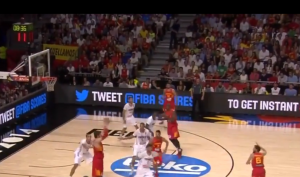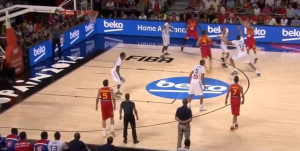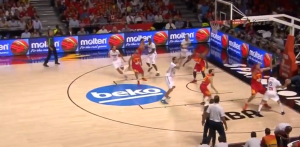In Non-Moving Pictures: How France Shocked Spain
Shocking as Spain’s loss against France may have been, it can be explained by a pretty straightforward narrative. The seemingly formidable Spanish front line had one major weakness: they lacked a shooter that would spread the floor and allow his teammates to make the most of the Gasol brothers’ creativity from the low block and the high post. The French defense, anchored by Rudy Gobert, took away scoring opportunities inside and Spain’s struggles from the perimeter made life easier for Vincent Collet. On the other end, Diaw provided everything Spain missed from the power forward position and Thomas Heurtel made his hardcore fans proud.
Personally, I have no problem with this narrative, as long as we are looking for an answer about the end result. To find out the root causes of yesterday’s upset, though, we need to dig deeper. A closer look at the numbers reveals a couple of extra issues for Spain. Their post up offense was quite inefficient (6 points on 11 plays) and it failed to act as the starting point of the beautiful ball movement we have come to expect from Orenga’s team. Again, the lack of perimeter shooting partly explains Spain’s shortcomings, but France did not really flood the strong side with help defenders. In many cases, rushed shots and a lack of counter actions was the real issue:
On this play, Pau Gasol makes a proper read of the French defense and kicks the ball out to Sergio Rodriguez. One of the options for Chacho is a pull up jumper, but Antoine Diot recovers in time after helping down low. Still, Spain have a lot of time on the clock to look for another high percentage look. Only they don’t seem to look hard enough. Once Rodriguez receives the ball, everything freezes – there are no cuts, no attempted pick and roll play. Eventually, S-Rod tries to get rid of his man off the dribble and once he fails to do so, fires an airball from behind the arc. It was hardly the only time Spain’s possessions featured too much dribbling and not much else.
Even though a pick and roll offense without a stretch four – Serge Ibaka was not the man for the job in this tournament – is a risky endeavor, it can work with a few tweaks. Spain was in desperate need of such adjustments but often went away too early from ideas that worked:
This image offers an interesting solution to spacing problems. Ibaka has been moved to the strong side, making harder for his man to cheat as a help defender inside. Had Florent Pietrus moved closer to the ball, Ibaka would have the opportunity to make a cut directly at the rim, where he can finish with authority. On the other end of the floor, Nic Batum has to stay home on Navarro and Mikael Gelabale lacks the size to stop the roll of Gasol, who draws a shooting foul. Why Spain didn’t run this play more often is a mystery.
The hosts of the tournament also failed to generate and capitalize on transition opportunities. Their defense in this game may look great on paper (France scored 65 points on the same number of possessions) but it didn’t really help their offense. In the first half, Spain got killed by the French movement off the ball, especially back door and baseline cuts. It is worth noting that on the group game between the two teams, France committed 15 turnovers, with Spain getting eleven steals, many of which lead to transition plays. Yesterday France had one more turnover, but Spain recorded seven steals less. Collet had his players ready to move when their opponents played the passing lanes or collapsed on the ball handler. As a result, the Spaniards often got caught looking at the ball.
On this screenshot, Diot looks like he is in trouble. He’s picked up his dribble and Pau has taken away the baseline. On a closer look, though, an opportunity emerges thanks to a lack of communication between Ricky Rubio and Ibaka:
Batum is free to cut along the baseline. Ibaka never sees his as he is concerned about Gobert rolling to the basket and none of his teammates inform him of what’s going on behind his back. As this video makes clear, such breakdowns occurred often, especially in the first half. Spain’s defense improved in the second half, thanks to greater individual concentration and effort, combined with a more conservative approach which put a premium on rim protection. And there is nothing wrong with that, except Spain failed to force enough live ball turnovers which would rejuvenate their offense. In the end, one of the most fearsome fast break teams of the tournament finished the game with only four transition points.
Transition basketball became even less accessible for Spain due to their rebounding struggles. When the communication isn’t there and rotations are not sharp enough, defenders don’t get the opportunity to box out properly. Simply put, the French offense gave their defense a chance to excel, while the Spanish defense did very little to help their offense. Collet learned his lesson from the group game. Now he needs to do the same against another familiar opponent: Serbia.



